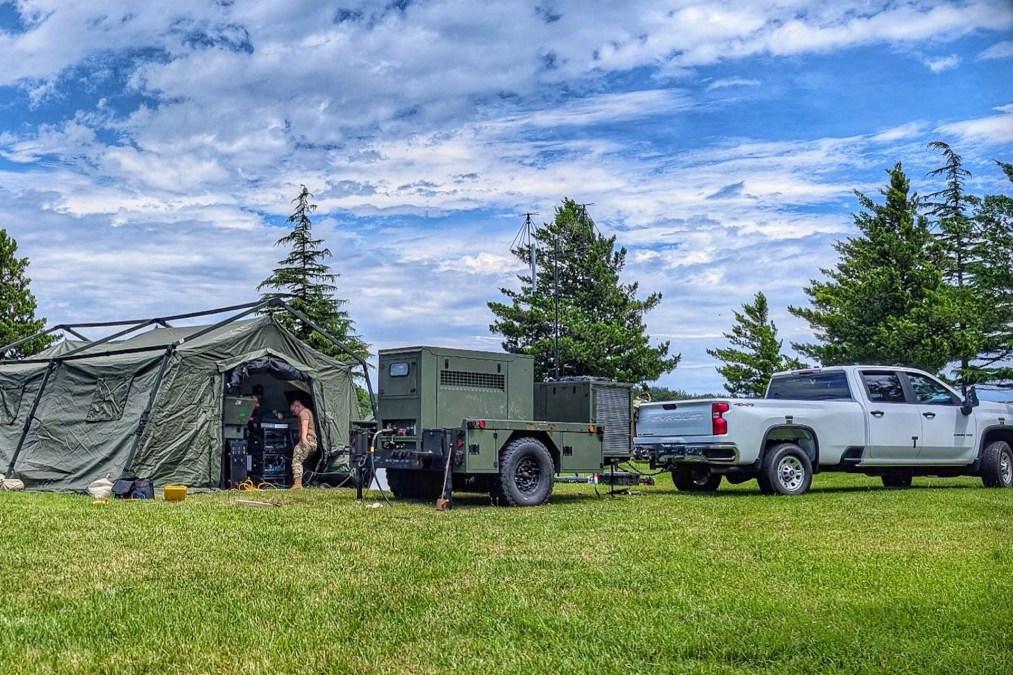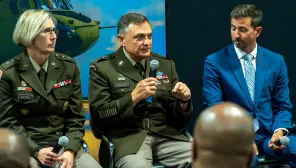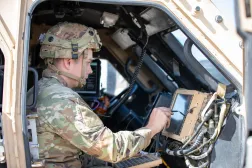Air Force tests logistics of next-gen C2 during huge REFORPAC exercise

As part of the Air Force’s massive exercise in the Indo-Pacific last summer, the service deployed prototypes of its new battle management kit to iron out how the mobile systems can be transported and used in a distributed battlespace.
During the inaugural Resolute Force Pacific event, the Air Force’s program office for command, control, communications and battle management (C3BM) managed to successfully position three Tactical Operations Center – Light (TOC-L) kits across three locations in the region. A key goal was not only to test the capabilities of the prototype systems, but also the Air Force’s ability to move the C2 kit and personnel in line with the service’s new Agile Combat Employment (ACE) strategy.
“The main objectives for TOC-L was to rapidly deploy forces to conduct those ACE objectives across the Pacific theater, and then utilize TOC-L for theater-wide distributed C2 and some decentralized authorities as well,” Stephen Ciulla, TOC-L program manager, told DefenseScoop in a recent interview about the results of the effort.
TOC-L is a lightweight, portable battle management system that can fuse hundreds of data streams from different radars and sensors to create an integrated air picture for battle managers. The Air Force is developing the kits to provide next-generation C2 capabilities in a smaller footprint, making them much easier to move than current ground-based systems like the Control and Reporting Center (CRC).
The deployment of the TOC-L systems was part of the first-ever REFORPAC — a massive, multi-national exercise that took place throughout the Indo-Pacific from July to August. The event was a component of the new Department Level Exercise (DLE) series that includes other major training events, all of which focus on the different mission areas needed to conduct large-scale operations in future conflicts in the Pacific region.
Led by PEO C3BM and the 752nd Operations Support Squadron, the exercise required moving two TOC-L systems and personnel from Tinker Air Force Base in Oklahoma to two locations in Japan. After multiple convoys and international flights, the service successfully deployed one system at Misawa Air Base and the other at Yokota Air Base, Capt. Andrew Millette, the 752nd’s chief of group exercises, said in an interview.
The third kit used during the exercise was already stationed at Anderson Air Force Base in Guam, but still required moving dozens of people across the world, Millette added.
“For command and control, which doesn’t typically move as much outside of being on an aircraft like an [Airborne Warning and Control System] or the since-retired [Joint Surveillance Target Attack Radar System], this was really the first big movement for us as a community to test how we were going to get overseas,” he said.
And while the exercise was an overall success, officials told DefenseScoop that it did expose new logistical challenges and different ways to move the equipment in the future — especially as the service continues to plan for a more austere form of operations under the ACE concept.
Broadly, ACE involves creating a network of geographically dispersed locations to conduct operations instead of relying on large, centralized bases that can be easily targeted by adversaries. The Air Force is developing the concept to prepare for potential conflicts with adversaries like China in the Indo-Pacific, where it wants to leverage small teams of airmen using highly-mobile systems that can be quickly deployed or moved.
“Logistics is not easy, even though [TOC-L] is a very tactical small kit. How we move is something we’re currently updating and improving, and so I think we learned quite a bit about how to get the kit from one location to another, how to move it on an island and to different locations,” said Lt. Col. Micah Graber, materiel leader of PEO C3BM’s Advanced Battle Management System Division’s deployable systems branch.
Beyond addressing logistical nuances, REFORPAC also allowed the Air Force to test out and refine the TOC-L’s capabilities. Personnel were able to successfully connect to and talk with aircraft, other command-and-control agencies, leadership at Tinker and other TOC-L sites — which was a critical objective, Millette said.
Ciulla noted that the system was also able to receive and display a common operating picture sent by Japan. There were some difficulties viewing an entire Japanese air picture, but the hurdles represented policy issues rather than technical flaws with the TOC-L, he told DefenseScoop.
“We have definitely validated that the capability TOC-L brings is an improvement of what they have today in the [AN/TYQ-23A],” Ciulla said. “It’s smaller [and] lighter, it can pull in data from sensors and radars, it can fuse the data, provide a common operating picture [and] give them all the better decision-making ability.”
Because the Air Force is taking an iterative approach with TOC-L’s development, lessons learned regarding logistics and capabilities will help inform the system’s next iteration known as Major Release 2 — which is being built by Booz Allen Hamilton. PEO C3BM is hoping to have the next version of TOC-L ready to test out during the upcoming Valiant Shield exercise in 2026, Graber said.
“We’re bringing a lot of lessons learned. We have some better [size, weight and power] goodness coming in. We’ve added some more sensor connectivities so that if we encounter local sensors, we should be able to plug-and-play almost right away,” he told DefenseScoop.






